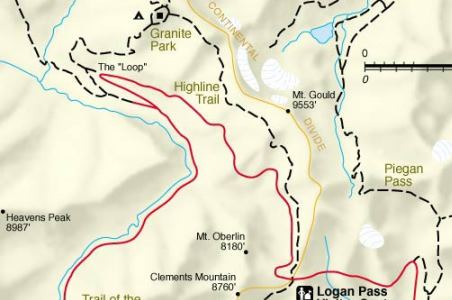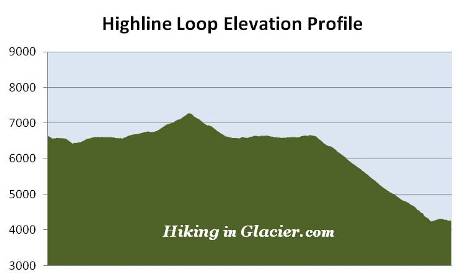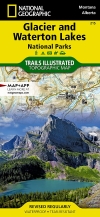
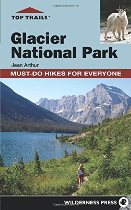
The Highline Loop
| Trail Features: | Outstanding views, Alpine meadows, flowers | 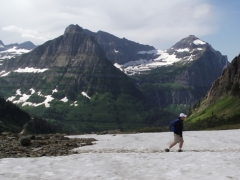 |
|||
| Trail Location: | Logan Pass | ||||
| Roundtrip Length: | 11.8 Miles | ||||
| Total Elevation Gain: | 1950 Feet | ||||
| Avg. Elev Gain / Mile: | 331 Feet | ||||
| Highest Elevation: | 7280 Feet | ||||
| Trail Difficulty Rating: | 15.70 (strenuous) | ||||
| Parking Lot Latitude | 48.69657 | ||||
| Parking Lot Longitude | -113.71813 | ||||
Trail Description:
The Highline Loop in Glacier National Park begins from the north side of the Going-to-the-Sun Road at Logan Pass. Although the hike includes the word "Loop" in its name, this is actually a one-way trek. The "Loop" refers to a bend in the road on the west side of the park where this hike ends. The best way to do this hike is to park at The Loop, located 13.1 miles east of the Lake McDonald Lodge on the Going-to-the-Sun Road, and then take the free shuttle up to Logan Pass.
The Highline Trail is an extremely popular hike; and for good reason. At every step, and every turn, hikers will enjoy spectacular scenery as they traverse along the Continental Divide, also known as the Garden Wall throughout this section of Glacier National Park. The exceptionally beautiful views, the excellent opportunities for spotting wildlife, and the wildflowers, all combine to make this a hike you'll remember the rest of your life.
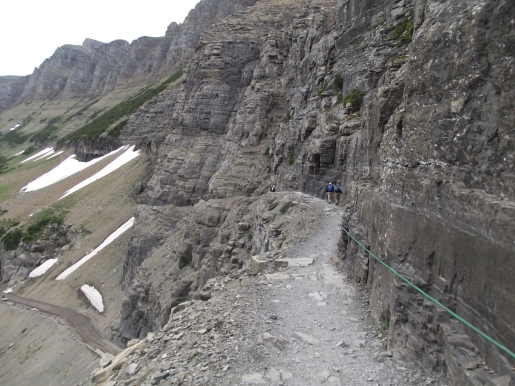
At roughly one-quarter of a mile from the trailhead hikers will arrive at the famous ledge with the reputation for terrifying those with a fear of heights. In most places the ledge, hanging like a shelf along the Garden Wall, is only six to eight feet in width, and has sheer drop-offs of roughly one hundred feet or more down to the Going-to-the-Sun Road below. This segment lasts for only three-tenths of a mile, but may seem forever if you have a fear of heights. Fortunately Glacier National Park has installed a hand cable along this stretch of the trail. My advice is to not let this deter you, as this is one of the most scenic hikes in America.
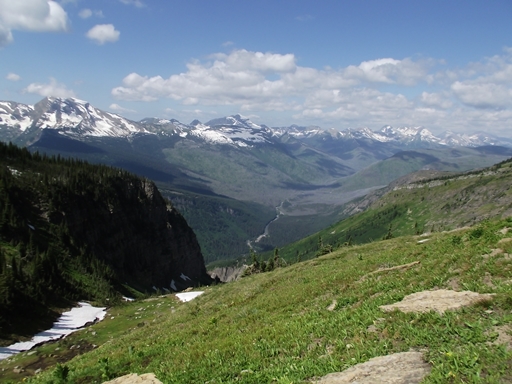
From the rimrock area the trail continues to hug the cliffs and slopes of the Garden Wall, and does so for most of its length to Granite Park. Throughout the early portions of the hike Mt. Cannon, Mt. Oberlin and Heavens Peak will dominate the views towards the west.
Roughly 2.5 miles from Logan Pass the slopes of the Garden Wall begin to moderate. Soon you'll begin the only major climb of the day, a short section of trail that leads hikers up to Haystack Pass.
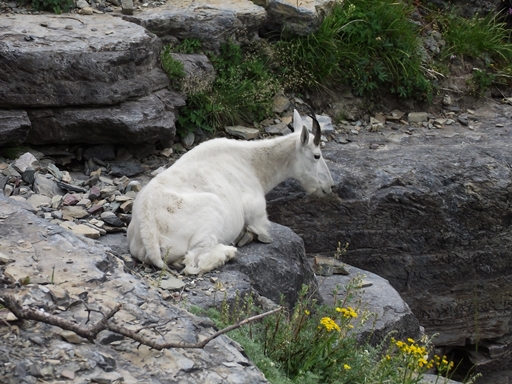
At 3.6 miles, after climbing roughly 275 feet along one long switchback, hikers will reach Haystack Pass. At an elevation of 7024 feet, the pass forms the saddle between 7486-foot Haystack Butte and the Garden Wall, which at this point is technically the southeastern flank of 9554-foot Mt. Gould. With its outstanding panoramic views, Haystack Pass is also a popular spot for an extended break.
Beyond the pass the trail continues to ascend along the Garden Wall. Soon you'll reach the highest point on the hike. After topping out at an elevation of roughly 7280 feet the trail begins descending towards Granite Park. As you proceed, 8436-foot Swiftcurrent Mountain will eventually come into view looking towards the north.
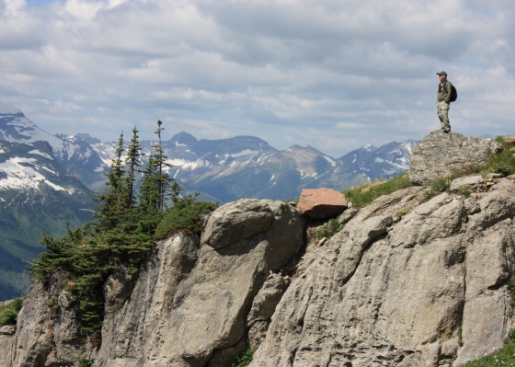
At 6.9 miles hikers will reach the Garden Wall Trail. This optional side trail climbs just over 900 feet - in less than nine-tenths of a mile - to reach the top of the Continental Divide, and provides hikers with a commanding birds-eye view of The Salamander and Grinnell Glacier on the opposite side.
At 7.6 miles hikers will reach the Granite Park Trail junction. Towards the right the Highline Trail continues towards the Fifty Mountain Backcountry Campground, located roughly 12 miles away. It also leads to the Swiftcurrent Pass Trail, located roughly two-tenths of a mile away. A turn to the left will lead you down to The Loop on the Going-to-the-Sun Road. To visit the Granite Park Chalet, hikers should proceed straight ahead at this junction.
The Granite Park Chalet was built in 1914 and 1915 by the Great Northern Railway to provide comfortable backcountry accommodations inside Glacier National Park. The rustic lodge was the last of the nine chalets built by the railroad, and today is listed as a National Historic Landmark. Compared to Sperry Chalet, the Granite Park Chalet is much more basic, and is essentially a simple hiker's hostel, with virtually no amenities. It has 12 guest rooms, each containing 2 to 6 bunks. Although there's no electricity, the common-area kitchen does have a propane stove that can be used to cook a warm lunch or dinner. For a more in-depth history of Glacier's historic hotels and backcountry chalet system, I highly recommend View with a Room.
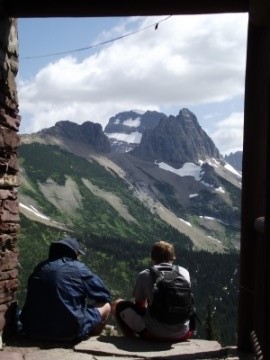
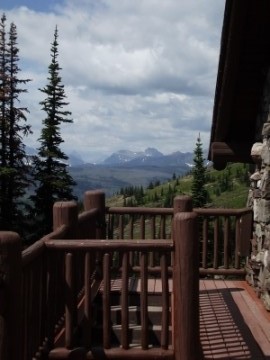
The chalet also sells packaged foods, beverages, snacks, and bottled water to day hikers. If not interested in buying water, there's a stream about a quarter-mile away along a rough and rugged trail. This water needs to be treated before drinking. For more information, and to make a reservation, please click here.
To continue towards The Loop on the Going-to-the-Sun Road hikers will now follow the Granite Park Trail. A little more than a half-mile below the chalet you'll reach the spur trail that leads to the Granite Park Backcountry Campground, which includes 4 individual campsites.
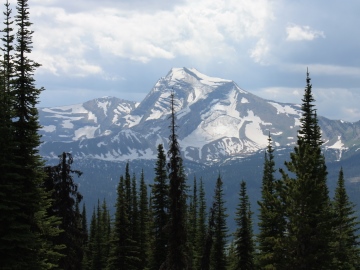 As you proceed down the Granite Park Trail, also known as the Loop Trail, you'll pass in and out of pine stands. Once beyond this forested area the terrain begins to open up again. The massive 8987-foot Heavens Peak will dominate the views across the valley. Below the mountain is the McDonald Creek Valley. In this same area, roughly 9 miles from Logan Pass, you'll also begin to notice the vast devastation inflicted by the 2003 Trapper Creek Fire. In many places, near the trail and across the valley, are the ghostly remains of thousands of dead trees.
As you proceed down the Granite Park Trail, also known as the Loop Trail, you'll pass in and out of pine stands. Once beyond this forested area the terrain begins to open up again. The massive 8987-foot Heavens Peak will dominate the views across the valley. Below the mountain is the McDonald Creek Valley. In this same area, roughly 9 miles from Logan Pass, you'll also begin to notice the vast devastation inflicted by the 2003 Trapper Creek Fire. In many places, near the trail and across the valley, are the ghostly remains of thousands of dead trees.
Prior to 2003 the Granite Park Trail passed through heavily wooded terrain, but the lightning ignited wildfire, which burned more than 19,000 acres, swept through and opened up vistas of the surrounding mountains. The forest, however, is already in the process of regeneration. Today you'll find extensive undergrowth, including thousands of wildflowers.
At 11.2 miles hikers will reach the bottom of the descent at the Packers Roost Trail junction. To continue towards The Loop Trailhead turn left at this fork and walk another half-mile to reach a footbridge. From this stream crossing the trailhead is only a tenth-of-a-mile away.
Because much of this route passes through prime grizzly bear habitat, it's extremely important for hikers to make a lot of noise, carry bear spray, and hike in groups. It's also a good idea to check with a ranger on the status of recent bear activity before proceeding on any hike in the park as well.
